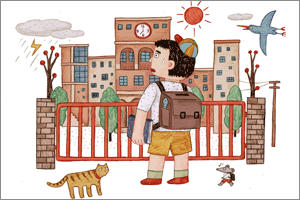A Guide to First Grade
First Grade
Elementary school begins in first grade. But in spirit, children begin first grade as kindergartners. Much happens over the course of the year to transform little children into young boys and girls. First-graders do not seem as wild as kindergartners -- after all, they are more developed physically, neurologically, and psychologically. They are gaining more control over their bodies, both at the fine motor level (first-grade art often shows a big representational leap over kindergarten art) and at the large muscle level (first grade is when children often begin to show interest in specific sports). Your child has a better sense of self than she did a year ago, and less of a need to live in the here and now. And she is ready and willing to use her mind. This is what first grade is all about. It is a fun and fulfilling year.
What to Expect
1. A big emphasis on reading. Children range from reading fluently as preschoolers to still being unsure of their letters when they leave kindergarten.
2. Numbers, numbers, and more numbers. There is lots of math in first grade -- and it all seems like fun: sorting and classifying, reading and writing numerals, seeking patterns, working with tallying and statistics, exploring shapes and measurement.
3. A little bit of homework. These days, most first-grade teachers tend to give a few minutes of homework once or twice a week to reinforce some classroom lessons.
4. Writing, but not spelling. First-graders are given many chances to write. But what is on a child's mind at this age can outstrip his physical ability to hold the pencil and form the letters. Acceptance of "inventive" spelling is another part of helping children embrace the writing process.
5. Increased emotional and physical independence. Children quickly learn to walk into the classroom themselves, then progress into other areas of self-management, such as hanging up coats (as the weather cools), returning library books, and handing in homework.
6. Concentration. Kindergartners learn to listen in a circle; first-graders sit at their desks and listen to what is going on without getting distracted or requiring attention. This ability to concentrate develops over the course of the year, and sets the stage for second-grade academics.
Watch Out for:
- Slow readers. Do your best not to pressure your child into reading if he does not seem eager, and try not to force him to show you what he has been learning. How quickly a child learns to read has nothing to do with overall brightness or long-term reading ability.
- Too much television. Research has shown that limiting television to 10 hours or less a week may assist a child in his reading; more TV-watching has been shown to slow reading achievement.
- Pent-up feelings. First-graders are still emotional beings, likely to cry, yell, hit, or even throw tantrums when upset. This is a good age to begin urging your child to talk about feelings, and to guide her in beginning to find her own solutions to problems.
超實用!家有小一新鮮人必看懶人包:Part1 應備物品篇
小一新鮮人要開學了,爸媽最該注意些什麼呢 ? 開學第一天,手忙腳亂的,家長又要如何面對開學日?哪些東西是一定要為孩子準備好的,哪些又是千萬不要買的地雷文具用品呢?小編整理了家長們在親子天下粉絲們的熱情留言,提供給家有小一新鮮人的爸媽們做開學參考。
【Part1】 應備物品篇
1. 鉛筆盒:不買多功能鉛筆盒 →布材質為佳
在鉛筆盒的選擇上,網友多數建議,不要買那種多功能、像玩具(會有一堆開關、或是可以打彈珠)的鉛筆盒,越簡單越好,以免孩子上課分心。家長也建議少用鐵的鉛筆盒,以免掉到地上造成巨大聲響,干擾上課。
網友「賴榮娟」認為,鉛筆盒最好是布的材質,髒了還可以洗。另外,網友「洪恩惠」則分享,她會和孩子一起準備文具,趁機機會教育,讓孩子理解,為什麼筆袋裡要放這些東西。
2. 筆:不適合用自動鉛筆 →鉛筆為佳
在筆的選擇上,網友們多認為小一生不適合使用自動鉛筆。網友” Wang Fei” 表示,初學寫字的孩子用自動筆,除了故障不會修理外,也會因為握力不當,使筆芯一直斷掉。爸媽最好為孩子準備鉛筆,初學寫字可以用三角形的胖胖筆,或加上握筆器輔助。
網友「黃瑜萍」建議,可以為孩子準備藍筆、紅筆各一支,不買多色一支組的原子筆,因為上課時孩子可能會喀嚓喀嚓一直按筆頭,自己分心,也影響到其他同學。此外,也可為孩子準備一兩支不同色的螢光筆,用來畫課本的重點。
3. 橡皮擦:不買彩色造型橡皮擦 →實用為佳
網友建議選擇橡皮擦時,不要買那種可愛動物造型,或是顏色鮮豔的橡皮擦,這種橡皮擦通常擦不乾淨,且多未經檢驗,可能含有塑化劑或含鉛量過高。網友「黃瑜萍」建議,家長可以自己先試用橡皮擦,最好是擦完後,橡皮擦屑是一長條狀的,好用也好清理。
4. 書套:準備防滑書套
網友"Tang-Yun Chou"提醒,務必用書套將書籍保護好。網友「賴榮娟」則建議,最好是買防滑書套,不然有些習作或作業本,可能因為孩子在寫字、修改擦拭時,力道沒拿捏好,簿本滑動而不好擦。
5. 書包:不買行李箱書包 →輕巧好背為佳
多數家長建議,不要買行李箱式(拉桿式)的書包。除了上下樓不便,網友「林小玉」也分享,拖拉時會有噪音,且擺在座位也會比較佔空間。網友” Wang Fei”也說,拉桿式的書包空的就快兩公斤,過馬路時常發生拉桿書包因地面不平而側翻,小孩為了調整書包角度而停留在馬路中間,非常危險!另有網友建議,可以使用幼稚園畢業時送的書包,以及最好是使用雙肩背、輕巧的書包。
6. 姓名貼:可製作姓名貼、標籤紙
網友建議,開學前可以做好孩子的姓名貼,或讓孩子在標籤紙上寫名子,並貼在自己的物品上。網友「賴榮娟」分享,可以和孩子一起將文具用品貼上標籤,加深孩子對自己用品的印象,不然東西掉了都不知道。網友"Wang Fei"則建議,可以為孩子製作姓名連續印章,寫學習單或考卷時可以馬上蓋名子。
7. 其他建議:餐具組等物品
網友分享,餐具組通常可以向學校訂購,學校也可能會贈送。另外也別忘了為孩子準備水杯、水壺,以及可夾學習單或通知單的文件夾,還有手帕、衛生紙、電話卡和小零錢包等。制服的部分,通常學校會提供訂購。
開學用品4地雷
1.不買多功能鉛筆盒→布材質為佳
2.不用自動鉛筆→鉛筆為佳
3.不買造型橡皮擦→實用為佳
4.不買行李箱書包→輕巧好背為佳
小一新鮮人要開學了,爸媽最該注意些什麼呢 ? 開學第一天,手忙腳亂的,家長又要如何面對開學日?哪些東西是一定要為孩子準備好的,哪些又是千萬不要買的地雷文具用品呢?小編整理了家長們在親子天下粉絲們的熱情留言,提供給家有小一新鮮人的爸媽們做開學參考。
【Part1】 應備物品篇
1. 鉛筆盒:不買多功能鉛筆盒 →布材質為佳
在鉛筆盒的選擇上,網友多數建議,不要買那種多功能、像玩具(會有一堆開關、或是可以打彈珠)的鉛筆盒,越簡單越好,以免孩子上課分心。家長也建議少用鐵的鉛筆盒,以免掉到地上造成巨大聲響,干擾上課。
網友「賴榮娟」認為,鉛筆盒最好是布的材質,髒了還可以洗。另外,網友「洪恩惠」則分享,她會和孩子一起準備文具,趁機機會教育,讓孩子理解,為什麼筆袋裡要放這些東西。
2. 筆:不適合用自動鉛筆 →鉛筆為佳
在筆的選擇上,網友們多認為小一生不適合使用自動鉛筆。網友” Wang Fei” 表示,初學寫字的孩子用自動筆,除了故障不會修理外,也會因為握力不當,使筆芯一直斷掉。爸媽最好為孩子準備鉛筆,初學寫字可以用三角形的胖胖筆,或加上握筆器輔助。
網友「黃瑜萍」建議,可以為孩子準備藍筆、紅筆各一支,不買多色一支組的原子筆,因為上課時孩子可能會喀嚓喀嚓一直按筆頭,自己分心,也影響到其他同學。此外,也可為孩子準備一兩支不同色的螢光筆,用來畫課本的重點。
3. 橡皮擦:不買彩色造型橡皮擦 →實用為佳
網友建議選擇橡皮擦時,不要買那種可愛動物造型,或是顏色鮮豔的橡皮擦,這種橡皮擦通常擦不乾淨,且多未經檢驗,可能含有塑化劑或含鉛量過高。網友「黃瑜萍」建議,家長可以自己先試用橡皮擦,最好是擦完後,橡皮擦屑是一長條狀的,好用也好清理。
4. 書套:準備防滑書套
網友"Tang-Yun Chou"提醒,務必用書套將書籍保護好。網友「賴榮娟」則建議,最好是買防滑書套,不然有些習作或作業本,可能因為孩子在寫字、修改擦拭時,力道沒拿捏好,簿本滑動而不好擦。
5. 書包:不買行李箱書包 →輕巧好背為佳
多數家長建議,不要買行李箱式(拉桿式)的書包。除了上下樓不便,網友「林小玉」也分享,拖拉時會有噪音,且擺在座位也會比較佔空間。網友” Wang Fei”也說,拉桿式的書包空的就快兩公斤,過馬路時常發生拉桿書包因地面不平而側翻,小孩為了調整書包角度而停留在馬路中間,非常危險!另有網友建議,可以使用幼稚園畢業時送的書包,以及最好是使用雙肩背、輕巧的書包。
6. 姓名貼:可製作姓名貼、標籤紙
網友建議,開學前可以做好孩子的姓名貼,或讓孩子在標籤紙上寫名子,並貼在自己的物品上。網友「賴榮娟」分享,可以和孩子一起將文具用品貼上標籤,加深孩子對自己用品的印象,不然東西掉了都不知道。網友"Wang Fei"則建議,可以為孩子製作姓名連續印章,寫學習單或考卷時可以馬上蓋名子。
7. 其他建議:餐具組等物品
網友分享,餐具組通常可以向學校訂購,學校也可能會贈送。另外也別忘了為孩子準備水杯、水壺,以及可夾學習單或通知單的文件夾,還有手帕、衛生紙、電話卡和小零錢包等。制服的部分,通常學校會提供訂購。
開學用品4地雷
1.不買多功能鉛筆盒→布材質為佳
2.不用自動鉛筆→鉛筆為佳
3.不買造型橡皮擦→實用為佳
4.不買行李箱書包→輕巧好背為佳

